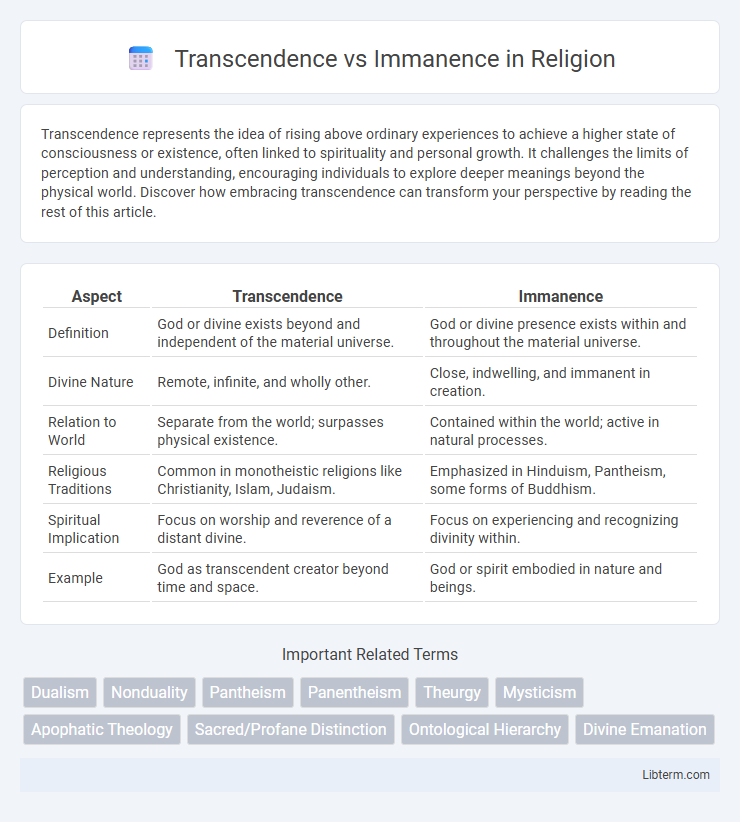Transcendence represents the idea of rising above ordinary experiences to achieve a higher state of consciousness or existence, often linked to spirituality and personal growth. It challenges the limits of perception and understanding, encouraging individuals to explore deeper meanings beyond the physical world. Discover how embracing transcendence can transform your perspective by reading the rest of this article.
Table of Comparison
| Aspect | Transcendence | Immanence |
|---|---|---|
| Definition | God or divine exists beyond and independent of the material universe. | God or divine presence exists within and throughout the material universe. |
| Divine Nature | Remote, infinite, and wholly other. | Close, indwelling, and immanent in creation. |
| Relation to World | Separate from the world; surpasses physical existence. | Contained within the world; active in natural processes. |
| Religious Traditions | Common in monotheistic religions like Christianity, Islam, Judaism. | Emphasized in Hinduism, Pantheism, some forms of Buddhism. |
| Spiritual Implication | Focus on worship and reverence of a distant divine. | Focus on experiencing and recognizing divinity within. |
| Example | God as transcendent creator beyond time and space. | God or spirit embodied in nature and beings. |
Understanding Transcendence: Beyond the Ordinary
Transcendence refers to the experience or state of existing beyond the ordinary physical world and its limitations, often associated with spiritual elevation or higher consciousness. It emphasizes surpassing empirical reality and accessing a realm that is infinite, eternal, and beyond human perception. This concept is central in many philosophical, religious, and metaphysical traditions that explore the nature of existence beyond material boundaries.
Defining Immanence: The Divine Within
Immanence refers to the presence of the divine within the material world and every individual, suggesting that the sacred permeates all aspects of existence rather than existing apart from it. This concept highlights an intrinsic connection between the divine and creation, emphasizing that spiritual reality is accessible and manifest within natural phenomena and human experience. Philosophical and theological traditions such as pantheism and certain strands of mysticism underscore immanence as the foundational principle that God or ultimate reality is inherently present within the universe itself.
Historical Perspectives: Transcendence and Immanence in Philosophy
Throughout the history of philosophy, transcendence has often been associated with the idea of a reality beyond human experience, as seen in the works of Plato and Kant, who emphasized forms or noumena existing independent of material existence. Immanence, conversely, has been explored by philosophers like Spinoza and Deleuze, who argue for the divine or ultimate reality existing within and throughout the material world. This dichotomy between transcendence and immanence frames many metaphysical debates, influencing theological, existential, and phenomenological discourses on the nature of being and the universe.
Transcendence in World Religions
Transcendence in world religions refers to the divine presence existing beyond and independent from the material universe, emphasizing a realm or state surpassing human experience. Major faiths like Christianity underscore God's transcendence by highlighting His omnipotence and otherness, while Islam stresses Allah's transcendence through the concept of divine incomparability. Hinduism also addresses transcendence through Brahman, the ultimate reality beyond the physical world and sensory perception.
Immanence in Spiritual and Secular Thought
Immanence in spiritual thought emphasizes the divine presence permeating all aspects of the universe, reflecting an intimate connection between the sacred and the material world. In secular philosophy, immanence signifies inherent qualities or forces existing within natural phenomena, independent of supernatural influence, often underpinning existential and humanist perspectives. Both frameworks highlight an indwelling reality where meaning and value arise internally rather than from an external, transcendent source.
Key Differences Between Transcendence and Immanence
Transcendence refers to the aspect of reality or divinity that exists beyond and independent from the physical universe, emphasizing separation and superiority over the material world. Immanence, on the other hand, highlights the presence of the divine or ultimate reality within and throughout the physical universe, stressing closeness and indwelling existence. Key differences focus on transcendence's external surpassing nature versus immanence's internal pervading presence within creation.
Mysticism: Bridging Transcendence and Immanence
Mysticism explores the intricate relationship between transcendence and immanence by emphasizing direct, experiential knowledge of the divine within and beyond the self. This spiritual approach bridges the gap by acknowledging that the ultimate reality is both beyond human comprehension and inherently present in the material world. Through practices like meditation and contemplation, mystics seek unity with the transcendent while recognizing the immanence of divine presence in everyday life.
Contemporary Debates on Divine Presence
Contemporary debates on divine presence emphasize the tension between transcendence, the idea of God as wholly other and beyond human experience, and immanence, the notion of God actively dwelling within the world and human life. Philosophers and theologians examine how divine presence manifests in modern spirituality, with immanence often linked to process theology and transcendence associated with classical theism. This discourse influences interfaith dialogues and impacts contemporary interpretations of sacred texts and spiritual practices.
Transcendence and Immanence in Modern Spirituality
Transcendence in modern spirituality refers to the experience or concept of existing beyond ordinary physical limits, often emphasizing connection with a higher, ineffable reality or divine presence. Immanence highlights the belief that the divine or sacred exists within the natural world and human experience, fostering a sense of unity and presence in everyday life. Contemporary spiritual practices blend transcendence and immanence by encouraging both the pursuit of extraordinary spiritual states and the recognition of sacredness in the present moment.
The Impact of Belief: How Worldviews Shape Human Experience
Beliefs in transcendence conceptualize reality as extending beyond physical existence, influencing human purpose and ethical frameworks by emphasizing connection to a higher power or ultimate reality. Immanence-focused worldviews root meaning within the natural, material world, encouraging self-realization and communal interdependence without external divine intervention. These contrasting perspectives shape psychological resilience, social behavior, and cultural values by framing how individuals interpret suffering, purpose, and the nature of existence.
Transcendence Infographic

 libterm.com
libterm.com